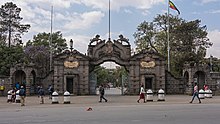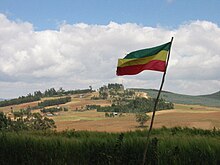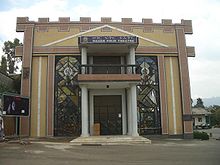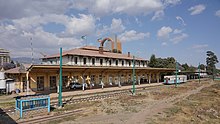Addis Ababa
|
Addis Ababa አዲስ አበባ |
||
 Light rail in the Lideta district (2018) |
||
| State : |
|
|
| Region : | Addis Ababa | |
| Founded : | 1886 | |
| Coordinates : | 9 ° 1 ' N , 38 ° 45' E | |
| Height : | 2,355 meters above sea level | |
| Area : | 530.14 km² | |
| Residents : | 3,352,000 (2016) | |
| Population density : | 6,323 inhabitants per km² | |
| Time zone : | EAT (UTC + 3) | |
| Telephone code : | (+251) (0) 11 | |
| Structure : | 10 boroughs | |
| Mayor : | Takele Uma Banti | |
| Website : | ||
|
|
||
Addis Ababa ([ adˈɪs ˈa [ː] beba also aˈbeːba ], also Addis Ababa ; Amharic አዲስ አበባ [ adːis aβɛβa , colloquially adːis aβa ], 'New Flower') is the capital of Ethiopia . In the language of the Oromo , the city will Finfinne or Shaggar called. Addis Ababa is the seat of the UN Economic Commission for Africa and the headquarters of the African Union .
geography
Addis Ababa has an area of about 530 km². The city, which is almost in the center of Ethiopia, lies between 2200 and 3000 meters above sea level at the foot of Mount Entoto , making it the third highest capital in the world and the highest in Africa.
history
Before Addis Ababa was founded, the Abyssinian Empire had no fixed capital for a long time. From 1881 Menelik II , at that time still King of Shewa , resided on Mount Entoto near today's Addis Ababa. This temporary camp in Central Ethiopia had some advantages for Menelik II.On the one hand, the place is more southern than previous capitals, which made it easier for him to unite the south with the north of the country under his rule; on the other hand, the place has historical significance as the legendary residence of medieval kings.
In November 1886, while Menelik II was in distant regions of the country, his wife Taytu Betul moved the camp from the hills down into the valley to where the city is today. It is reported that she left the camp at Entoto because of the uncomfortably low temperatures and that she liked the place near the hot Fel Weha springs more.
More decisive, however, were the geographical conditions at this location, which, in contrast to the camp at Entoto, offered sufficient space for the establishment of a city as Menelik II imagined it. After his return, Menelik II also found pleasure in this place.
In 1889 the first palace for Emperor Menelik II was built here, the country's first aqueduct was laid, and the first telegraph office was set up in a round hut, a tukull. In 1892 Menelik II named the city of Addis Ababa , "New Flower", and made it the capital of Abyssinia . The first bank, then Bank of Abyssinia , was founded in 1905, the first school in 1908, the first hospital in 1910, and the first printing house in 1911. Significantly, the first cinema existed as early as 1898, popularly called Yä-Šäyṭan Bet (Devil's House).
As a result of the Abyssinian War , the city became part of Italian East Africa in 1936 , and from February 19 to 21, 1937, the great fascist massacre of Yekatit 12 took place. During World War II, British troops captured the capital of the Italian colony of Abyssinia on April 5, 1941.
population
All ethnic groups in the country live in Addis Ababa. The majority of the population in the city are the Amhars with a share of approx. 60% (status: 2011 census).
The city's population has increased almost tenfold since 1950. Addis Ababa is one of the fastest growing cities in the world. The main reason for this is migration from the rural regions of Ethiopia, because Addis Ababa has the lowest fertility rate in the whole country with only 1.4 children per woman . The population is expected to rise to 13.2 million by 2050.
Population development of the agglomeration according to the UN
| year | population |
|---|---|
| 1950 | 392,000 |
| 1960 | 519,000 |
| 1970 | 729,000 |
| 1980 | 1,175,000 |
| 1990 | 1,791,000 |
| 2000 | 2,377,000 |
| 2010 | 3,126,000 |
| 2017 | 4,216,000 |
Administrative structure
Addis Ababa is divided into 10 subcities (districts or districts) and 99 Kebeles . The subcities have their own administrative structures; Subordinate to them, the Kebeles form the smallest administrative unit in the city.
The 10 subcities of Addis Ababa are: Arada, Kirkos, Gullele, Kolfe Keranyo, Akaki-Kality, Nefas Silk-Lafto, Lideta, Bole, Addis Ketema and Yeka.
Cityscape
modernity
Today Addis Ababa is not only the political capital, but also the economic and social center of Ethiopia. Wide boulevards criss-cross the city, multi-storey buildings can be found alongside traditional one or two-storey houses, open spaces and forest areas that are mainly overgrown with eucalyptus trees. Due to the high altitude, the climate in Addis Ababa is mild. Addis Ababa has a university that was founded in 1950, as well as art and music schools and some research facilities. Since the 1950s, the city is the unofficial capital of Africa considered and was not least because in 1958 the seat of the Economic Commission of the United Nations for Africa (United Nations Economic Commission for Africa, UN / ECA) and in 1963 the seat of the Organization of African Unity (OAU, since 2002 African Union , AU). There are also over 90 consulates in Addis Ababa.
As a cosmopolitan city, Addis Ababa offers a wide range of hotels, from international luxury hotels to cheap deals.
poverty
Away from the business districts, poverty is very present in Addis Ababa. In the 1950s, Addis Ababa was compared with the suburbs of major European cities that were spacious and full of gardens and bungalows, but this picture has changed since the 1960s. The city began to grow rapidly and the water and electricity supply did not keep pace. That is why hundreds of thousands of their citizens today have to fetch their water from distribution points and often use public latrines a few hundred meters away .
There are many begging and mutilated as a result of the civil war on the streets. The sick often cannot afford to see a doctor. Despite the poverty, the city is considered relatively safe. There is little serious crime; Pickpocketing is one of the most common offenses.
The waste is only about 0.15 kg per day and inhabitant, because a lot is recycled or a lot of organic waste is eaten by goats and other animals. For over 50 years, the city has operated the Koshe (“dirt”) garbage dump as the main disposal site . On March 11, 2017, part of the heap of rubbish slipped and spilled dozen huts at the foot of the dump and in the adjacent poor district. Excavators were used to dig for people who had been buried - mostly people looking for usable items in the garbage. After 2 days, "at least 65 dead" were recorded, after 6 days 113. The city administration is already building a new rubbish dump, which is not yet in operation. This Koshe dump had been closed for some time, but was reopened because farmers resisted another planned dump.
There is a sewerage system for only 200,000 of the approximately three million inhabitants. This was still built by the Italians. With the support of the German Society for Technical Cooperation ( GTZ ), four central urban areas were developed, and GTZ also promoted housing construction and the training of the craftsmen required for this.
Ecological damage
As can be observed in many other African countries, there are a lot of older cars in Addis Ababa, which pollute the air with their exhaust gases. In some cases, cars and trucks have been used for decades. Industrial companies also produce high emissions that endanger the health of residents. In many households, wood is used for cooking and heating (it can get very chilly in Addis Ababa at night), which also releases enormous emissions into the air.
Probably the biggest problem is that most people do not have access to safe drinking water. Most households do not have a water connection, so people use publicly accessible water points, be it rivers that flow through the city or wells. These water points are often highly polluted with faeces and industrial waste. In addition, the sewer system is completely inadequate and cannot withstand the demands of a city with a population of several million.
Since access to clean drinking water and functioning sanitary facilities are essential for people's health, the lack of this is responsible for a large number of diseases that occur. One of the consequences of this is an enormously high infant mortality rate.
Attractions
Mercato
The largest market in Addis Ababa is the Mercato in the Addis Ketema district . The name of the market comes from the time of the Italian occupation (1936 to 1941). Customers are offered a wide range of products of all kinds. The Mercato, officially Addis Mercato (“New Market”), is the largest open-air marketplace in Africa and employs an estimated 13,000 people. The market is divided into product types; H. Stores selling groceries, housewares, textiles, electronics, etc. a. sell, are each arranged in a separate area. In addition to products for everyday use, regional handicrafts and antiques are also sold to tourists. The market is closed on Sundays.
Close to the market are the Al-Anwar Mosque and the Cathedral of the Holy Family, which are worth seeing.
university
The spacious building of the University of Addis Ababa, which previously served as a palace for Emperor Haile Selassie I, is located in Addis . The Institute for Ethiopian Studies and the Ethnological Museum as well as an exhibition of historical Ethiopian works of art are located here.
Menelik Mausoleum
The Menelik Mausoleum is located in the old Baata Church. It serves as a crypt for emperors, princes and martyrs . It was built as the final resting place for Emperor Menelik II and also houses the remains of other family members.
George Cathedral
The modern Gännätä-Tsige-Mänagäscha-Qïddus-Gïyorgis Church (ገነተ ጽጌ መናገሻ ቅዱስ ግዮርጊስ) is at the north end of Churchill Road . The cathedral was built in the traditional octagonal shape in 1896 by Emperor Menelik II to commemorate his victory at Adwa against the Italians. The architect was Sebastian Castagna. The cathedral was built by the Italians who were defeated in the battle at Adwa and finally captured. It is dedicated to the national saint of Ethiopia. The Italian fascists looted the cathedral in 1937 during the war. However, after the liberation, the building was restored in 1941. The church's museum houses a large collection of religious paintings, crosses, historical books, parchments and handicrafts. It also contains a collection of modern works of art by the famous Ethiopian artist Afewerk Tekle .
Trinity Cathedral
The Mänbärä-Tsäba'ot-Aga'ïstä-Aläm-Qïddus-Sïllase Cathedral (መንበረ ጸባዖት አጋዕሥተ ዓለም ቅዱስ ሥላሴ) was built in 1941 according to a European design and is intended to commemorate the liberation from the occupation by Italy (1936–1941). In the crypt is the crypt of the emperor Haile Selassie I.
Africa Hall
This magnificent building opposite the former “new imperial palace” was the seat of the Organization for African Unity , which was founded there in 1963, for many years . The gigantic stained glass (a triptych of three windows with a total of 150 m²) by the Ethiopian "national painter" Afewerk Tekle , which symbolizes "Africa's past, present and future" (created in 1958) , is of cultural interest .
Entoto
Addis Ababa lies at the foot of Mount Entoto. From the 3000 meter high plateau you have a panoramic view of the entire city. The Marienkirche ( entoto maryam , built in 1885) on the mountain overlooks the entire city and the surrounding area. The Entoto Museum houses a historical exhibition.
Hager Fikir Theater
The city's oldest indigenous theater, founded in 1935, is located in the historic Piassa district of Addis Ababa. A number of singers, actors and dancers began their careers here in the past few decades. Some of them, for example Aster Aweke , later had an international breakthrough. The main entrance of the Hager Fikir Theater has been decorated with a glass facade by the artist Sium Ajano since 2002 .
"Red Terror" Martyrs' Memorial Museum
The “Red Terror” Martyrs' Memorial Museum in Addis Ababa was established in 2010 as a memorial for the victims of the Marxist Derg regime .
economy
In the center of the historic Shewa Province , Addis Ababa is located in the heart of Ethiopia and has good transport links with all parts of the country. There is an international airport here as well as a rail link to Djibouti since 1917 . An extensive network of trunk roads, some of which can be used in any weather, connects Addis Ababa in a star shape with almost all other cities in Ethiopia. There are also road links with Kenya (via the Moyale border crossing ), Djibouti (via the Galifi crossing ), Sudan (via the Metema border crossing ), South Sudan , Somaliland , Somalia and Eritrea . However, the border crossings to Eritrea have been closed since May 18, 1998 and have not yet reopened.
The country's industry is concentrated in the greater Addis Ababa area. This primarily serves the domestic market and focuses on the food and luxury goods industry, textile industry, building materials, metal processing and chemical products. The headquarters of the Ethiopian automobile manufacturer Holland Car , which was founded there in 2005 as a joint venture between a Dutch company and an Ethiopian and went bankrupt in 2013, was in Addis Ababa .
traffic
A large number of international airlines fly to Addis Ababa Airport several times a week . Within Ethiopia, Ethiopian Airlines is the only airline from Addis Ababa to offer flights to 16 cities; T. several times a day.
Local public transport is organized by the Anbessa City Bus Service Enterprise buses and taxis / community taxis, which are uniformly blue and white in color. The shared taxis are usually minibuses that can accommodate at least twelve people and travel along set routes. Two people are responsible for a shared taxi , the driver and a so-called Weyala who collects the fare and calls out the destination of the trip to passers-by on the street. Long-distance transport is organized and operated by the bus companies Selam Bus Line Share Company , Sky Bus Transportation System and a number of other private companies. There are bus connections to the main cities of Ethiopia and Nairobi in Kenya .
Construction of the Addis Ababa Ring Road began in 1998 to implement the urban development plan and advance suburban development. The Ring Road was built in three main phases, which should connect all five main gates of Addis Ababa with all other regions of the country ( Jimma , Debre Zeit , Asmara , Gojjam and Ambo ). In this project, the China Road and Bridge Corporation (CRBC) was a partner of the Addis Ababa City Roads Authority (AACRA). The Ring Road has made a significant contribution to unbundling and easing city car traffic. The main roads in Addis Ababa are mostly paved and in good condition. The contrast between tradition and modernity can partly be seen in the use of the streets by modern cars and at the same time by donkey carts.
At the end of December 2011, the plan for the construction of an approximately 37 km (total of 3 lines, which, however, partially overlap) long light rail in Addis Ababa was published. The construction work is being carried out by the China Railway Eryuan Engineering Group Co. Ltd. (CREEC).
The light rail, which is expected to cost over USD 400 million, is to be financed 60% by the Chinese government and 40% by the Ethiopian government. Completion was planned for the end of 2013, but there were considerable delays due to the simultaneous construction of a road bridge from Meskel Square to Bole Road.
The light rail is the first south of the Sahara and has standard gauge and a 750 V DC overhead line. The opening of public operations on the first 17 km long line from the center to the industrial south took place on September 21, 2015. The costs for the construction of the Meskal Square Bole Bridge are estimated at an additional 60 million USD and will be completed funded by the Export Import Bank of China . A ride costs 6 birr (US $ 0.27). A second line is under construction. A railway to Djibouti, also financed by China, which connects to the light rail in the south and west, is to follow. A Chinese bond covered 85% of the $ 475 million cost of the light rail. It will be operated by the Shenzhen Metro Group and China Railway Engineering Corporation for the next 5 years .
sons and daughters of the town
- Wilfred Thesiger (1910-2003), British researcher and explorer
- Aklilu Habte-Wold (1912–1974), politician
- Girma Wolde-Giorgis (1924–2018), President of Ethiopia (2001–13)
- Endelkachew Makonnen (1927–1974), politician, Prime Minister of Ethiopia 1974
- Mikael Imru (1929–2008), politician, Prime Minister of Ethiopia
- Kifle Wodajo (1936–2004), diplomat and politician
- Tilahun Gesesse (1940–2009), singer
- Asfa-Wossen Asserate (* 1948), Ethiopian-German management consultant and author
- Hubert Auriol (* 1952), French motocross and enduro racing driver, rally driver
- Ermias Sahle-Selassie (* 1960), President of the Ethiopian Crown Council and grandson of Emperor Haile Selassie
- Dennenesch Zoudé (* 1966), German television and film actress
- Petros Berga (* 1967), Roman Catholic clergyman
- Girma Yifrashewa (* 1967), composer and pianist
- Julie Mehretu (* 1970), artist
- Liya Kebede (* 1978), model and UN special envoy
- Dinaw Mengestu (* 1978), writer
- Million Wolde (* 1979), long-distance runner and Olympic champion
- Bethlehem Alemu (* 1980), entrepreneur
- Benjamin Kibebe (* 1981), Swedish football player
- Eyerusalem Kuma (* 1981), long-distance runner
- Elvan Abeylegesse (* 1982), Ethiopian-Turkish athlete
- Ruth Negga (* 1982), Ethiopian-Irish actress
- Bezunesh Bekele (* 1983), long-distance runner
- Meseret Defar (* 1983), track and field athlete and Olympic champion
- Alemayehu Bezabeh (* 1986), Spanish long-distance runner
- Tadese Tola (* 1987), long-distance runner
- Layes Abdullayeva (* 1991), Azerbaijani middle-distance, long-distance and obstacle runner of Ethiopian origin
- Kalkidan Gezahegne (* 1991), middle distance runner
- Jonas Koller (* 1993), German long-distance runner
Town twinning
Addis Ababa has twinned cities
-
 Ankara , Turkey, 2006
Ankara , Turkey, 2006 -
 Be'er Scheva , Israel, since 2004
Be'er Scheva , Israel, since 2004 -
 Chuncheon and Seoul , South Korea
Chuncheon and Seoul , South Korea -
 Johannesburg , 2003
Johannesburg , 2003 -
 Khartoum , Sudan
Khartoum , Sudan -
 Leipzig , Germany, since 2004
Leipzig , Germany, since 2004 -
 Lusaka , Zambia, 2005
Lusaka , Zambia, 2005 -
 Lyon , France, 2009
Lyon , France, 2009 -
 Nairobi , Kenya, 1968
Nairobi , Kenya, 1968 -
 Beijing and Chongqing , China
Beijing and Chongqing , China -
 Sanaa , Yemen, 2007
Sanaa , Yemen, 2007 -
 Saint Petersburg , Russia, 2011
Saint Petersburg , Russia, 2011
Climate table
| Addis Ababa | ||||||||||||||||||||||||||||||||||||||||||||||||
|---|---|---|---|---|---|---|---|---|---|---|---|---|---|---|---|---|---|---|---|---|---|---|---|---|---|---|---|---|---|---|---|---|---|---|---|---|---|---|---|---|---|---|---|---|---|---|---|---|
| Climate diagram | ||||||||||||||||||||||||||||||||||||||||||||||||
| ||||||||||||||||||||||||||||||||||||||||||||||||
|
Average monthly temperatures and rainfall for Addis Ababa
Source: wetterkontor.de
|
|||||||||||||||||||||||||||||||||||||||||||||||||||||||||||||||||||||||||||||||||||||||||||||||||||||||||||||||||||||||||||||||||||||||||||||||||||||||||||||||||||||
The climate of Addis Ababa is warm-temperate due to its altitude (type Cwb ), i.e. a subtropical highland climate, consisting of long, warm, humid summers and short, mild, dry winters. Most of the rains fall in the months (June to September), the winter months are much drier.
literature
- Ivo Strecker: Addis Ababa: The new flower blooms red. In: Geo , 1/1978, pp. 32–52 (report by Menelik II to 4th Head of State Mengistu Haile Mariam )
Web links
- Official website of the city of Addis Ababa (English)
- City map of Addis Ababa
- Website of the Embassy of the Federal Republic of Germany
- Website of the Goethe-Institut Addis Abeba Gebrekristos Desta Center
- The Official Web Site of Addis Ababa University
- Pictures of Addis Ababa from www.raineralbiez-vulkane.de
Individual evidence
- ↑ Central Statistics Agency (Ethiopia): Population Projection of Ethiopia from all Regions at Wereda Level for 2014-2017. (No longer available online.) Archived from the original on October 17, 2015 ; Retrieved August 25, 2016 (English, Amharic).
- ^ Deutsches Historisches Museum: Chronicle 1941 , queried on April 5, 2011
- ↑ City population 2050 | Sustainability Today. Retrieved July 24, 2018 .
- ↑ World Urbanization Prospects - Population Division - United Nations. Retrieved July 23, 2018 .
- ↑ List of subcities ( memento of July 3, 2013 in the Internet Archive ) in the sitemap of the city's official website, accessed on December 12, 2012.
- ↑ Accident on a garbage dump in Ethiopia - the number of deaths rose to 65 , orf.at, March 13, 2017, accessed on March 14, 2017.
- ↑ Landslide in Ethiopia: number of victims increased to 113 , orf.at, March 17, 2017, accessed on March 17, 2017.
- ↑ Ethiopia: Addis Ababa Urban Profile. UN Habitat, 2008, pp. 8f, 12
- ^ Economic Development . Embassy of Ethiopia, Berlin. Archived from the original on January 21, 2012. Retrieved January 14, 2012.
- ↑ Holland Car: The pride of Ethiopia: About Us . Holland Car. June 25, 2013. Archived from the original on September 12, 2015. Retrieved January 14, 2012.
- ↑ Selam Bus SC website . Retrieved May 13, 2020.
- ↑ Sky Bus Ethiopia website . Archived from the original on December 31, 2011. Retrieved January 13, 2012.
- ↑ INTERNATIONAL CONFERENCE ON MULTI-NATIONAL CONSTRUCTION PROJECTS: Addis Ababa Ring Road Project - A Case Study of a Chinese ... . Retrieved December 8, 2010.
- ^ Addis Ababa Light Railway project starts . Retrieved January 12, 2012.
- ^ Sub-Saharan Africa gets its first metro. In: The Economist , September 22, 2015.
- ^ Sister Cities of Addis Ababa. (PDF) Retrieved November 30, 2018 (English).
- ^ Addis Ababa Climate & Temperature. addis-ababa.climatemps.com








